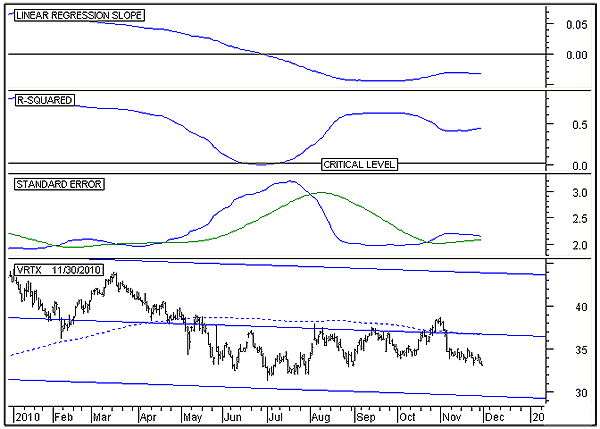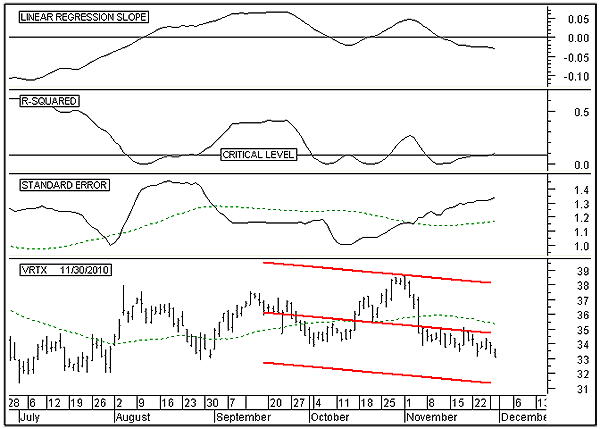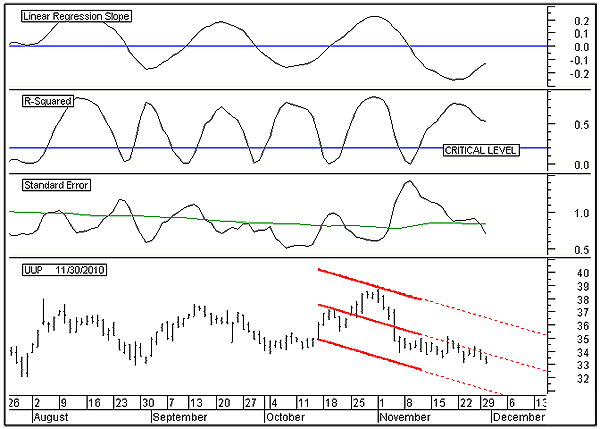
HOT TOPICS LIST
- MACD
- Fibonacci
- RSI
- Gann
- ADXR
- Stochastics
- Volume
- Triangles
- Futures
- Cycles
- Volatility
- ZIGZAG
- MESA
- Retracement
- Aroon
INDICATORS LIST
LIST OF TOPICS
PRINT THIS ARTICLE
by Alan R. Northam
Before taking a position in this security it is important that I first look at its technical condition. In this analysis I use linear regression as the analysis tool to determine the overall trend of this pharmaceutical company and when to time my trade.
Position: N/A
Alan R. Northam
Alan Northam lives in the Dallas, Texas area and as an electronic engineer gave him an analytical mind from which he has developed a thorough knowledge of stock market technical analysis. His abilities to analyze the future direction of the stock market has allowed him to successfully trade of his own portfolio over the last 30 years. Mr. Northam is now retired and trading the stock market full time. You can reach him at inquiry@tradersclassroom.com or by visiting his website at http://www.tradersclassroom.com. You can also follow him on Twitter @TradersClassrm.
PRINT THIS ARTICLE
LINEAR REG CHANNEL
A Statistical Analysis Of Vertex Pharmaceuticals
12/01/10 09:35:04 AMby Alan R. Northam
Before taking a position in this security it is important that I first look at its technical condition. In this analysis I use linear regression as the analysis tool to determine the overall trend of this pharmaceutical company and when to time my trade.
Position: N/A
| Vertex Pharmaceuticals, which belongs in the health-care market sector, engages in the discovery, development, and commercialization of small molecule drugs for the treatment of serious diseases worldwide. Before I consider trading any security, I first take a look at its overall picture, including the long-term, intermediate-term, and short-term trends. To this end, I'll start my analysis of Vertex with a long-term view. |
| Figure 1 shows me the long-term picture of Vertex. The bottom panel shows the price action from the beginning of 2010. On this chart I have plotted the 200-day linear regression line and its upper and lower linear regression channels. As a result, I see that the linear regression line is sloping in a downward direction, indicating that the long-term trend is in a downward direction. I also note that price has also been trading below the 200-day simple moving average and that the moving average is moving in a downward direction. Here, I use the 200-day simple moving average as a confirming signal that the long-term trend is down. In the top panel I show the linear regression slope indicator. This indicator tells me that the long-term downtrend turned downward near the end of June when it crossed below its zero line. However, this indicator is off its September low, indicating that the down slope of the long-term trend is no longer increasing, further indicating that price is not accelerating in the downward direction. The second panel shows the R-squared indicator, which represents the strength of the trend. Here I note that this indicator crossed above its critical level in early July, indicating that there now exists a 95% probability that the long-term downtrend will continue for quite some time. However, this indicator is off its September highs, indicating that the long-term downtrend is no longer increasing in strength. In the third panel, I have shown the standard error indicator, which represents volatility. Volatility is a measure of the deviation of price from the linear regression line. Here I see that this indicator has crossed above its 50-day simple moving average in mid-October, indicating an increase in volatility. High levels of volatility normally indicate a change in trend in the near future. However, I am not concerned here, as the standard error indicator is moving back lower toward its 50-day moving average. From this long-term analysis, I feel confident that the long-term downtrend will continue for quite some time. However, I do not feel that the slope of this long-term downtrend will increase in the downward direction. Therefore, any shorter-term downtrends should find its limits at the edge of the lower linear regression channel line. |

|
| FIGURE 1: VRTX, DAILY. This chart shows the 200-day linear regression channel on the price chart in the bottom panel, the linear regression slope indicator in the top panel, the R-squared indicator in the second panel, and the standard error indicator in the third. |
| Graphic provided by: MetaStock. |
| |
| The next time frame I want to look at is the intermediate-term time frame. This is the time frame over which I like to hold my positions. In Figure 2 I see the intermediate-term time frame for Vertex. The bottom panel shows the price action over the last several months. On this chart I have plotted the 50-day linear regression line along with its upper and lower channel lines. These channel lines provide support and resistance price areas. Note that from mid-September, the linear regression line and its channel lines have been sloping downward. In the upper panel of Figure 2, I see that the linear regression slope indicator moved below its zero line in mid-November and continues to point down. This indicates that the 50-day linear regression line continues to steepen in the downward direction, which tells me that price is continuing to accelerate downward. In the next panel, I look at the R-squared indicator, which indicates the strength of the trend. This indicator has recently moved above its critical level. This informs me that there now exists a 95% probability that the intermediate-term downtrend will continue for some time. Since intermediate-term trends last from several weeks to several months, I at least expect the intermediate-term trend to last into the new year. The third panel down shows the standard error indicator. This indicator is a measure of volatility. In this chart I see that this indicator has been moving upward since mid-October and is now above its 50-day simple moving average. As long as this indicator continues to move up, it is an indication that price will continue to move away from the linear regression line downward. This then informs me that the intermediate-term linear regression line should continue to accelerate to the downside. This analysis shows me that price over the intermediate term should continue to accelerate downward through the balance of 2010 and into 2011. |

|
| FIGURE 2: VRTX, DAILY. This chart shows the 50-day linear regression channel on the price chart in the bottom panel, the linear regression slope indicator in the top panel, the R-squared indicator in the second panel, and the standard error indicator in the third. |
| Graphic provided by: MetaStock. |
| |
| So far I have determined that Vertex is in a long-term downtrend. I have also determined that the intermediate-term trend is moving in the direction of the long-term trend and continues to accelerate downward. I have also determined that this downtrend should last for quite some time. Now all I need to do is to time my entry. For this, I look at the short-term trend. In the lower panel of Figure 3, I see the daily price action of VRTX over the last several months. I have also added the 20-day linear regression line and its channel lines. I have also added the extension lines as red dotted lines. This chart shows me that price is in a short-term downtrend and price is hugging the linear regression line. In looking at the linear regression slope indicator in the top panel, I see that this indicator has now turned upward. This informs me that the down slope of the 20-day linear regression line is now starting to become more shallow. This further tells me that price is starting to decelerate. Price deceleration normally occurs just before a trend reversal. In looking at the short-term downtrend, I see that it has been in progress now for about three weeks. Short-term trends normally last from a few days to a few weeks, and this trend has run its course. In the second panel from the top, I see that the R-squared indicator is moving downward. Since this indicator measures the strength of the trend, this indicator is informing me that the short-term trend is weakening. This also confirms that the short-term trend has run its course. Looking at the third panel from the top in Figure 3, I see the standard error indicator. This indicator measures volatility or the deviation of price from the linear regression line. This indicator continues to move down, indicating that price continues to hug the linear regression line. This tells me that price may continue to hug the linear regression line in the days ahead. This further tells me that although over the short-term price is starting to decelerate as the short-term trend continues to weaken, it may be several days yet before price turns the corner and starts to move upward. |

|
| FIGURE 1: UUP, DAILY. This chart shows the 20-day linear regression channel on the price chart in the bottom panel, the linear regression slope indicator in the top panel, the R-squared indicator in the second panel, and the standard error indicator in the third. |
| Graphic provided by: MetaStock. |
| |
| In conclusion, Vertex Pharmaceutical is in a long-term downtrend. However, the long-term downtrend is no longer accelerating down but continues to head lower at a constant rate. Therefore, the downside price target is limited to the current slope of the long-term lower channel line. Over the intermediate term, price is now accelerating downward. This informs me that the high-probability trades in Vertex is in shorting this security. To time the market as to when I should enter a short trade, I look at the short-term time frame. This time frame tells me that this security is about to turn upward. Therefore, I must wait for the short-term upward rally to complete itself before taking a short position in VRTX. Until that time, I will put Vertex Pharmaceutical on my short trade watchlist. |
Alan Northam lives in the Dallas, Texas area and as an electronic engineer gave him an analytical mind from which he has developed a thorough knowledge of stock market technical analysis. His abilities to analyze the future direction of the stock market has allowed him to successfully trade of his own portfolio over the last 30 years. Mr. Northam is now retired and trading the stock market full time. You can reach him at inquiry@tradersclassroom.com or by visiting his website at http://www.tradersclassroom.com. You can also follow him on Twitter @TradersClassrm.
| Garland, Tx | |
| Website: | www.tradersclassroom.com |
| E-mail address: | inquiry@tradersclassroom.com |
Click here for more information about our publications!
PRINT THIS ARTICLE

Request Information From Our Sponsors
- StockCharts.com, Inc.
- Candle Patterns
- Candlestick Charting Explained
- Intermarket Technical Analysis
- John Murphy on Chart Analysis
- John Murphy's Chart Pattern Recognition
- John Murphy's Market Message
- MurphyExplainsMarketAnalysis-Intermarket Analysis
- MurphyExplainsMarketAnalysis-Visual Analysis
- StockCharts.com
- Technical Analysis of the Financial Markets
- The Visual Investor
- VectorVest, Inc.
- Executive Premier Workshop
- One-Day Options Course
- OptionsPro
- Retirement Income Workshop
- Sure-Fire Trading Systems (VectorVest, Inc.)
- Trading as a Business Workshop
- VectorVest 7 EOD
- VectorVest 7 RealTime/IntraDay
- VectorVest AutoTester
- VectorVest Educational Services
- VectorVest OnLine
- VectorVest Options Analyzer
- VectorVest ProGraphics v6.0
- VectorVest ProTrader 7
- VectorVest RealTime Derby Tool
- VectorVest Simulator
- VectorVest Variator
- VectorVest Watchdog
